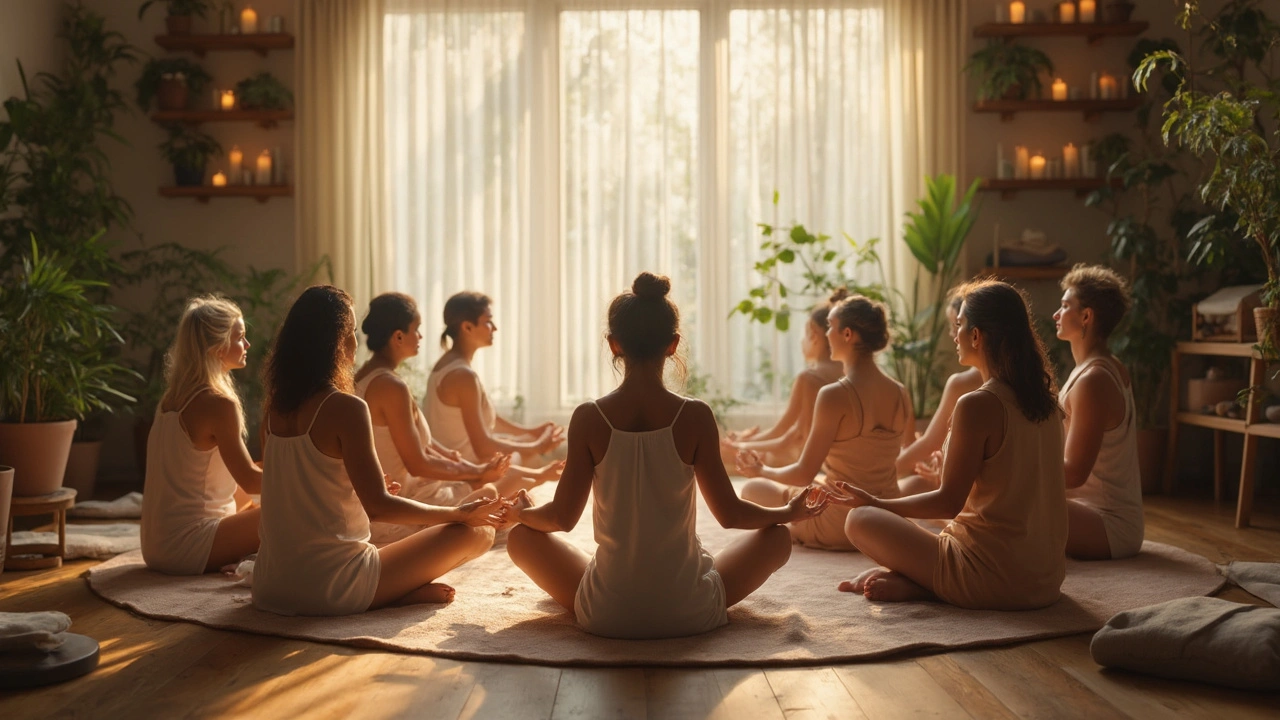Ever wondered why some folks roll out of a reiki massage session looking like they just found the pot of gold at the end of the rainbow? It’s not magic, and it isn’t just feel-good hype either. As wild as it sounds, laying on a table while someone gently places their hands on or above your body can flip the switch on stress, pain, anxiety—and way more. There’s a reason this energy-based practice has exploded in wellness circles and made its way into hospitals from New York to Tokyo. Want to crack the code and know why? Here’s the real story behind this quietly powerful technique that’s hitting sauna-level popularity in the self-care universe.
Reiki Massage Origins and Core Principles
Let’s kick things off with a little rewind. Reiki surfaced in Japan during the 1920s, thanks to Mikao Usui. Yep, that’s a century ago, but the vibe is anything but old-fashioned. Usui claimed to discover a way to channel universal life energy—called “rei” for universal and “ki” for life force—by using nothing more than hands. He wasn’t working with witchcraft, crystals, or potions. It was—and still is—about tapping into something unseen yet tangible, kind of like Wi-Fi for your body.
The core idea here? Everyone’s got an energy field. When it’s out of whack, it messes with your mood, sleep, even how fast you bounce back from the flu. Reiki practitioners believe their palms can ‘tune’ this energy by laying hands gently—or even hovering them—a few inches above certain points. They aren’t replacing doctors, but they sure want you to leave lighter and clearer.
It’s easy to lump reiki massage in with other bodywork styles, but here’s a catch—there’s barely any rubbing, kneading, or muscle crunching. You can stay fully clothed. Some sessions are so still you might wonder if the practitioner nodded off, but the shift you’ll feel is subtle, deep, and sometimes surprising. If you’re a skeptic (and honestly, most of us are at first), there’s good news: lots of clinical settings now offer reiki as pain and stress management support—not just in fancy spas, but hospitals. In 2019, NewYork-Presbyterian used it in pre-op to calm nerves before major surgeries. The US National Center for Complementary and Integrative Health even lists it as a complementary therapy, with research ongoing into its efficiency against anxiety, depression, and even cancer-related fatigue.
If you want to geek out over statistics, a 2022 survey published in the Journal of Integrative Medicine found 62% of regular participants reported “above average” improvement in stress and sleep after bi-weekly reiki sessions. That’s not a small number. Tables like the one below show just how much of a punch this seemingly gentle approach can pack.
| Reported Benefit | % of Reiki Clients Noticing Improvement |
|---|---|
| Reduced Anxiety | 68% |
| Improved Sleep | 62% |
| Pain Relief | 51% |
| Elevated Mood | 48% |
Whether you call it energy medicine, hands-on healing, or just “that chill-out thing my friend swears by,” its roots—and results—are hard to ignore.
How Reiki Massage Works: Techniques and What to Expect
Ready to picture the scene? A reiki massage session sounds simple, but there’s more to it than lying down and hoping for the best. First, you’ll meet your practitioner—some wear white, some look super laid-back. You keep your clothes on, get comfy (usually on a padded massage table or reclining chair), and the lights dim. The practitioner might ask what you’re hoping to address—maybe chronic headaches, anxiety, or just general burnout.
Session kicks off quietly. The practitioner tunes into your energy (think: palms slowly hovering or resting lightly on different spots, like your head, shoulders, arms, chest, legs, and feet). There’s no pressure, manipulation, or dramatic chanting. Instead, the movement is steady and calm, and most people report feeling gentle heat, tingling, or a wave-like sensation. Don’t be surprised if you doze off; that’s normal. Your brain gets a break from its usual high-alert mode, and even die-hard insomniacs say they catch deeper Z’s post-session.
Techniques can vary, but here’s a rundown of what you might experience:
- Hand Positions: Usually cover 12–20 areas from head to toe, holding each for a couple of minutes.
- Scanning: Some practitioners ‘scan’ with their hands above your body to detect pesky energy blockages.
- Intuitive Guidance: Once in a while, a seasoned reiki pro will linger on areas where they sense you need extra mojo.
- Distant Reiki: This surprises a lot of people—energy healing that works remotely. No, it’s not Zoom for chakras, but reiki fans rave about its results.
Each session lasts anywhere from 30 minutes to an hour. You don’t have to say much, but some people like to talk before or after. Is it weird if you don’t feel fireworks? Not at all. Changes are often subtle—a lighter mood, deeper sleep, or just feeling less ‘muddy’ in your head the next day.
Wondering who’s doing the hands-on part? Practitioners go through training and certification (levels I, II, and ‘Master’ status). Legit reiki therapists should be happy to show you credentials and answer basic questions. You might run into different styles—Usui, Karuna, or even animal reiki for your furry family. Regardless, the vibe is respectful, supportive, and meant to empower—not diagnose or replace your medical team.
Parents use it for stressed teens before exams, athletes before races, even busy professionals as a pre-deadline reset. Whatever the setting, the core purpose sticks: restoring your energy balance without side effects, pain, or complex equipment.

Proven Benefits and Who Should Try Reiki Massage
Now for the big question: Does reiki massage really work, or is it just a glorified nap? The science is catching up. Several 2021 meta-analyses (check out Clinical Oncology or the BMJ Supportive & Palliative Care journals) report that reiki decreased pain and anxiety in cancer patients more effectively than standard rest alone. Hospitals like Cleveland Clinic now invite reiki practitioners for post-op recovery sessions. The US Army uses reiki for wounded vets managing PTSD and chronic pain. If major medical centers see enough of a twist to give it a whirl, there’s probably more than placebo at play.
Here are some honest, everyday wins most folks mention after a few sessions:
- Calmer mind—less racing thoughts at bedtime.
- Softer muscle tension without the soreness of deep-tissue massage.
- A sense of emotional lightness or clarity.
- Boosted mood without caffeine or sugar crashes.
- User-friendly for all ages—kids, older adults, pregnant women (but always inform your practitioner if you’re pregnant).
- Fewer headaches or migraines in people with chronic pain syndromes.
- Stronger sense of mind-body connection, great for those feeling scattered or burnt out.
Of course, this isn’t a magic bullet. Still, reiki’s noninvasive nature makes it a safe add-on for just about anyone—even folks not into traditional massage. Chronic stress, emotional funk, sleep trouble, or just being curious about new self-care methods—reiki massage tends to draw all sorts.
Patients dealing with chronic illness, cancer, fibromyalgia, autoimmune issues, even those living with mental health bumps, often report a shift—sometimes dramatic, more often subtle. It’s like topping off your phone when the battery’s running low, only it’s you getting the recharge. Got a physical injury, chronic condition, or medication sensitivities? Reiki can slide into your wellness routine without butting heads with existing treatments. Doctors usually give the green light; just mention it during checkups, especially if you have pacemakers or active symptoms that need monitoring.
Ever been stuck at work, low on sleep, or frazzled by nonstop demands? Even one reiki session can feel like you’ve thrown water on burnout’s fire. But don’t expect life to completely flip overnight. Most people get the biggest boost after regular, short sessions over a few weeks. The data says consistency is key; scattered sessions fade fast, while habits build up long-haul results.
Tips for Getting Started and Making the Most of Reiki Massage
Thinking of booking your first reiki massage? You might be a bit nervous, but there’s no secret handshake or complicated prep. Just show up ready for something different. If you want the best shot at a game-changing session, try a few simple moves before and after.
- Hydrate well—your body’s energy field works best when you aren’t running on empty. Drink a glass of water ahead of your session.
- Avoid heavy meals. A full belly can distract you, and the whole point is calm and focused rest.
- Wear loose, comfortable clothing. You won’t need to undress, but comfort is always king.
- Bring an open mind. Even the coolest skeptics often get more out of new experiences when they’re not hypercritical from the start.
- Try to block off some chill time after your session. Jumping straight into a noisy meeting or stressful commute cancels out some of reiki’s peace-and-quiet magic.
- Don’t be shy—ask questions about your practitioner’s experience, style, or what to expect. Good reiki therapists love walking clients through the basics.
- If you’re juggling health issues or seeing a doctor, mention reiki in your care plan. It plays well with most conventional medicines, but transparency helps everyone.
Wondering where to find the right fit? Word of mouth is king—ask friends, coworkers, or your gym’s wellness team. Most legit reiki practitioners proudly show off their certificates and continuing education. Don’t feel locked in—a single session might help, but many notice the biggest impact after a series of three to five. Keep a journal about how you feel after each session. Energy changes are sometimes subtle, and looking back helps spot patterns.
If the cost is a sticking point, check local wellness clinics, community centers, or college training programs. They sometimes offer affordable or sliding-scale options. A growing number of insurance plans and HSAs now list reiki as eligible for reimbursement, especially if your doctor recommends it. Even virtual reiki sessions are on the rise, especially for busy schedules or when traveling.
Set realistic expectations. Some people feel transformed; others notice deep calm or just a good night’s sleep. The key is tuning in to your own reactions, not chasing someone else’s ‘aha’ moment. Give yourself the freedom to be curious—and if you ever feel uncomfortable, say so. The best reiki massage isn’t some mystical, unreachable art. It’s a hands-on (or hands-above) boost to your well-being—no incense or chanting required.


 Health and Wellness
Health and Wellness